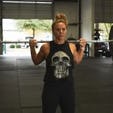So, you have been attending a regular commercial gym for quite some time, everything was fine and cool but then one day you watched some guys on YouTube performing insane feats of strength with unconventional training equipment; or you saw a cool article about this type of training and just had to try it; or something else (it doesn’t really matter).
What matters is that the switch in your head has flipped and you are now infected with a disease called “Unconventional Training Methods.” Now you crave to train in a completely unconventional way, however, there is a problem: what do you start with? No worries. This article will help you to choose your first unconventional training method.
Before we start, I want you to understand one important thing: every method has its advantages and disadvantages. There is no training tool that can develop everything. Some of them will be better for your current goals, some not. You should understand and embrace this fact as soon as possible. Otherwise, you will be frustrated when you discover limitations of the method that some people sell you as ultimate
Two Things to Consider When Starting with Unconventional Training
At this point, two scenarios come to my mind: You want to add unconventional methods to your current training routine and you want to solely train with unconventional methods. In both of them, you should be clear on your goals. This is important because you want to pick up the method that will deliver the results according to your goals.
In the first case, your objective may be to develop a certain quality or skill that conventional gym equipment cannot provide you. In this scenario, you should add the unconventional method that can help with your exact goal. You do not open a can with a hammer, right?
Therefore, do not choose a method just because it looks cool! Use something that can provide exactly what you’re looking for. For example, if your goal is to perform a Muscle Up on gym rings, you should get some rings are start performing pulling exercises like Pull Ups and Body Rows.
In the second case, you should choose the method according to their limitations. For example, my personal preference is a mix of calisthenics, kettlebells, and sandbags. Let’s analyze the limitations of each of these methods.
Unconventional Training Implement #1: Kettlebells
Calisthenics are not optimal for leg development (Pistol Squats get easy too fast), but kettlebells and sandbags can easily compensate this flaw. You can either add weight to Pistol Squats, or utilize Double Kettlebell Squats, or Sandbag Zercher Squats (just to name just a few).
Kettlebells and Calisthenics have huge jumps in intensity. You cannot just add 2.5kg to a kettelbell like you would with a barbell. If you mastered 24kg kettlebell, the next size will be 32kg. That is 8 kg! If you are doing double kettlebell work, that’s 16kg! The same is true for Calisthenics.
Unconventional Training Implement #2: Sandbags
If you are doing five repetitions in Advanced Tuck Planche Push Ups, you may struggle to finish even one rep in the next step, the Straddle Planche Push Up. However, with sandbags, you can overcome these limitations. The weight of the sandbag can be increased in as many increments as you wish.
Sandbags, on the other hand, cannot provide you with unique ballistic exercises like kettlebells can. As you can see, these three methods combine perfectly for me. You are free to use them as well; however, it will be way more awesome if you find the mix that is ideal for you. How? Read on.
Mixing Unconventional Training Implements
Now it’s time for the fun part. While knowing the advantages and disadvantages of unconventional training methods is a good start, it’s useless without proper, practical implementation. If you want to use just one new method to learn a certain skill, then it all depends on what you choose.
If it interferes with your regular strength training, then you’ll need to sacrifice something. If your goal is to learn the Planche exercise, then forget about maximum effort Bench Pressing. Put it into maintenance mode instead (do only as much as needed to save the skill and not tire yourself) and concentrate on the Planche.
On the other hand, if your goal doesn’t interfere with your regular routine, you can put it at the beginning or at the end of the training session. If it is a skill that should be performed frequently (like a Handstand), then put it at the beginning. If it is specialized strength work (like grippers), then put it at the end.
If you desire to use unconventional methods solely, then you should understand how to substitute exercises. There are 3 basic movement patterns for the compound drills (it’s not a science, just my personal observation): Pushing, Pulling, and Legs.
The Pushing category includes all the exercises where you press the resistance away from yourself; for example, the Bench Press, Handstand Push Up, Kettlebell Military Press, etc. Some people divide this category to horizontal and vertical pushing. However, let’s keep it simple. The Pulling category includes all the exercises where you pull the resistance to yourself; for example, Bent-Over Row, Pull Up, Kettlebell Renegade Row, etc.
The Legs category includes all the exercises that are based on the squatting movement patterns. Although the Deadlift is not the same thing as the Squat, you still bend your hips, knees, and ankles, so it belongs in here. Examples of this category include Kettlebell Swings, Sandbag Zercher Squats, and the Pistol Squat.
Incorporating Unconventional Training Implements into Your Program
Now you can take any program and just change the exercises to the ones you like according to the movement patterns. For example, let’s assume that the original workout looks like this:\
A1 – Barbell Bench Press – 3 sets x 5 reps
B1 – Barbell Bent-Over Row – 3 sets x 8 reps
C1 – Barbell Squat – 3 sets x 6 reps
Obviously, it contains 1 Push, 1 Pull, and 1 Leg exercise; just switch them to the similar exercises from the relevant category and you are good to go. For example:
A1 – Double Kettlebell Floor Press – 3 sets x 5 reps
B1 – Pull Up – 3 sets x 8 reps
C1 – Sandbag Zercher Squat – 3 sets x 6 reps
You can mix and match any way you like. Just use exercises from the relevant category. The same is true for isolation moves.
I hope this article helps you to get acquainted with unconventional strength training and how to get results with them. Thanks for reading. Play rough!



)





